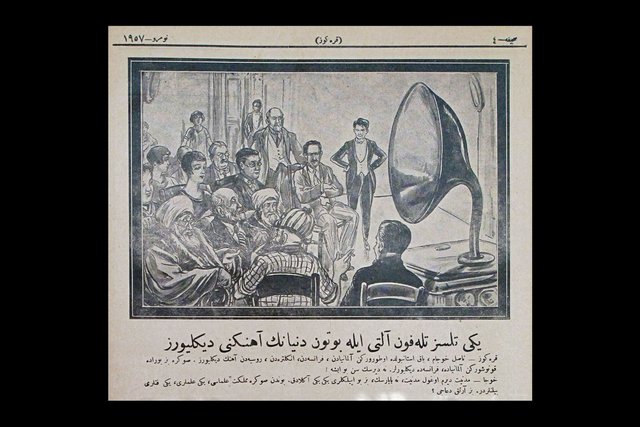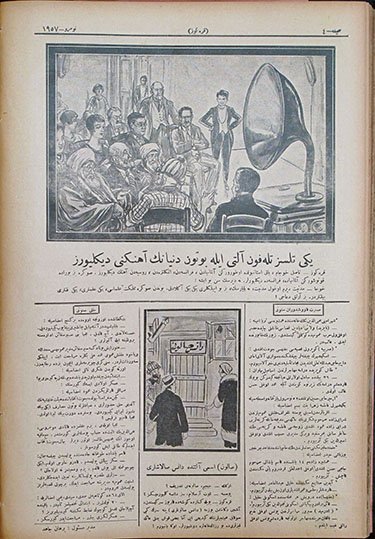128. Today in 1920s Turkey: 18 December 1926 (Wireless Radio Technology Comes with Civilizational Message)

(Cartoon, Karagöz, 18 December 1926, no. 1957, page 4.)
Comments
This illustration was featured on the back page of an issue of Karagöz from ninety-one years ago. Placed in a nondescript interior space, the image represents a group of people gathered in a semi-public room and listening intently to the sounds emerging from the conspicuously placed tube located in the right third of the composition. The imposing apparatus belongs to a radio receiver box (and not a gramophone, the technological device it is usually visually associated with). The crowd of well over a dozen people consists of dapper men in suits, fashionable women, and several turbaned members of the ulema or Muslim religious clergy. It is also customary for Karagöz, the magazine’s namesake shadow theater character and mascot to make an appearance in most illustrations. True to that model, Karagöz can be seen on the bottom row (identifiable by his voluminous hat and big black beard) as the second person from the right.
Here, with his back turned to the reader, Karagöz is engaged in a conversation with one of the religious clerics at the “hearing.” The nature of their conversation is no mystery as it is transcribed in the text below. Below is the transcription in modern Turkish followed by its English translation:
Türkçe:
Yeni Telsiz Telefon Altı ile Bütün Dünyanın Ahengini Dinliyoruz
Karagöz: Nasıl Hocam, bak İstanbul’da otururken Almanya’dan, Fransa’dan, İngiltere’den, Rusya’dan ahenk dinliyoruz. Sonra biz burada konuşurken Almanya’da, Fransa’da, dinliyorlar. Ne dersin sen bu işe!
Hoca: Medeniyet derim oğul, medeniyet. Ne yaparsın, biz bu iyilikleri yeni yeni anladık. Bundan sonra memleket uleması, yeni ilimleri, yeni fenleri bilenlerdir. Biz artık duacı?
English:
We Are Listening to All of the Melodies of the World with the New Wireless Telephone Receiver
Karagöz: How is it, my Hodja? Look as we sit in Istanbul we are listening to sounds from Germany, France, England, and Russia. And while we speak here they are listening to it in Germany and France. What do you have to say about this affair?
Hodja: I call this civilization, son, civilization. What can you do, we only recently understood these advantageous things. From now on the country’s ulema are those who know the new disciplines and sciences. Now are the ones who pray?
(… commentary continued)
The tone of the fictional conversation between the two characters reveals the text’s (and thus, the illustration’s) pursuasive objective. The wireless radio receiver around which the crowd is seated is of course, also the subject of the discussion. Following a brief explanation of device, including a list of the European countries whose “sounds” are now audible in Turkey, Karagöz uses this gathering as an opportunity to introduce the modern technological wonder to more conservative members of the community, represented by the senior religious scholars, who had a tendency to oppose or cast suspicion upon novel things, ideas, or practices, especially those imported from abroad (i.e. Euro-America). In response, the moderate Hodja of the dialogue concedes the technological achievements of “(modern) civilization” (medeniyet). Moreover, he reassigns the position of intellectual leadership, traditionally held by the scholarly ulema class to “those who know the new disciplines and sciences.” Concurrently, he demotes the role of religious clerics from thinkers and teachers to mere prayer-makers.
It was not uncommon for discussions about adopting new technologies to involve an element of binary support and opposition. The ulema were often singled out as a group with tendencies to reject new technology without considering its full potential and benefits to society. This illustration uses Karagöz as a cultural lubricant. Through both text and image he brings disparate parts of society together to all collectively witness the technological wonders of hearing music playing from far-away lands. In this way it functions to normalize and even create “buzz” or anticipation toward technology among its readership. In this way, “popular demand” can become the ultimate spreader of all things new and useful. For other examples of how Karagöz handles the subject of new technologies see:
114. Provincial Town Purchases Its Very Own Airplane
90. Gramophones Are Everywhere: Even in the Villages
48. Inauguration of First Transatlantic Telephone Service
39. Istanbul: Planning Ahead for Snow... in December

(Entire page, Karagöz, 18 December 1926, no. 1957, page 4.)
This post has been modified, updated, and re-posted on 18 December 2018. Access the new edition here.